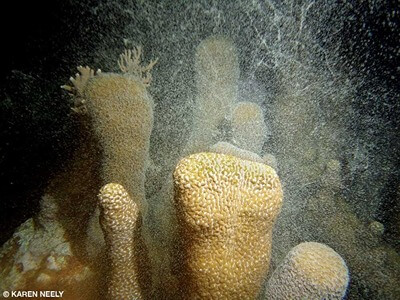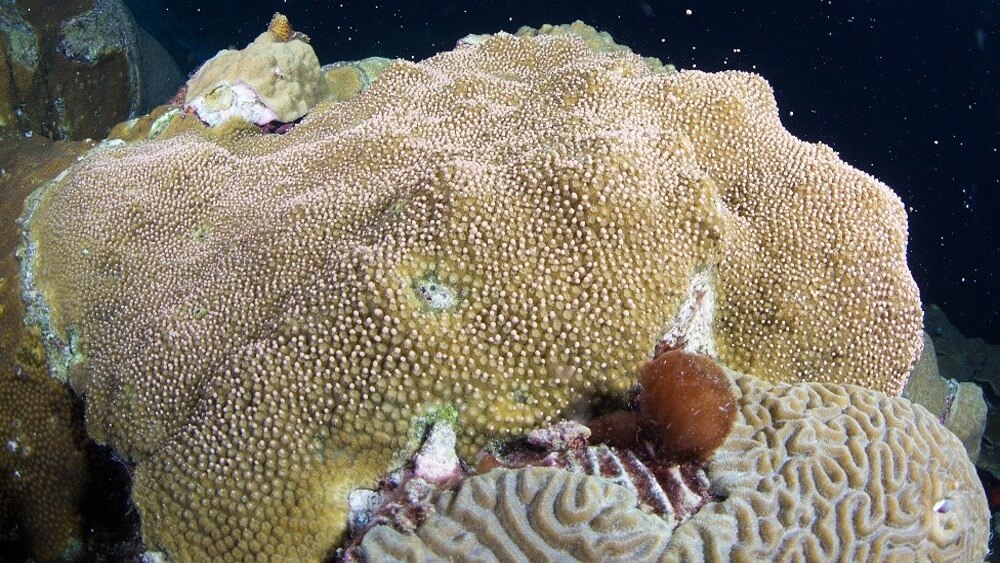Coral Reproduction and Recruitment

Conservation Issue
Florida’s reefs have experienced catastrophic losses of coral cover over the last four decades, and this has affected successful reproduction of corals, while concurrent declines in habitat quality has had negative consequences on recruitment. A critical step in successful reef recovery requires new information and strategies to enhance coral reproduction and recruitment, including techniques to address bottlenecks that have hindered large-scale production of corals from larval collections, enhanced production of larvae from resilient coral genotypes, and new efforts to improve habitat quality and increase natural recruitment.
Description
Coral spawning events for most species occur annually based on the full moon cycle in April/May (e.g., Diploria labyrinthiformis) and August/September (most other broadcast spawners). In addition to the lunar cycle, spawning events are also linked to water temperature, weather patterns, and cues from other marine organisms. Corals also rely on asexual reproduction through fragmentation, budding, or other means as an important means to increase biomass and cover. Because of large declines in abundances of corals and accelerating threats to coral reef ecosystems, recruitment levels are not keeping up with coral losses. Over the last 15 years, researchers have begun to increase population viability through both asexual propagation of corals and settlement of gametes collected during mass spawning events. Innovative outplanting strategies such as boulder coral “re-skinning” have reduced the time necessary for outplanted corals to reach sexual maturity, and re-skinned Orbicella colonies have spawned within five years of outplanting. Scientists are also propagating new species both sexually and asexually, and have begun incorporating novel techniques to induce lab spawning, enhance the genetic diversity of corals used in restoration, stress-harden corals to improve their survival, identify resistant genotypes, and improve habitat quality through herbivore reintroductions in an attempt to promote natural settlement and recruitment. While great advances are being made, additional research is needed to further scale up outplanting; improve lab-based reproduction, settlement and grow-out; enhance survival of outplanted corals; and improve settlement rates and survival of larvae with considerations for connectivity, water quality improvements, and reduction of nuisance species.
Data and Analysis Needs
- Potential bottlenecks to successful recruitment of larval corals (e.g., evaluation of chemical, physical, or physiological impediments that limit settlement and recruitment of corals)
- New techniques to promote spawning of laboratory corals and settlement of resulting larvae, including manipulations of light levels, feed, settlement substrates, and other environmental parameters
- Optimal techniques to promote rapid growth, survival, and reproduction of outplanted corals reared from settled larvae, including relationships between fragment size/age and outplant design
- Effectiveness of stress hardening, selection of particular genotypes, manipulation of symbionts, and other intervention techniques for enhancing species resilience, and whether these traits persist in outplanted corals and are passed on to their progeny
- Effect of water quality on successful larval recruitment of corals and relationships between waterborne pathogens, changing ocean conditions, and other impacts on successful natural reproduction, larval survival, and recruitment to reef substrates
- Options to enhance successful reproduction in wild corals, such as the establishment of spawning hubs
- Risks and benefits associated with translocation of corals and/or their gametes and larvae among countries and jurisdictions to enhance resilience, including cryopreserved sperm and eggs
Potential Products
- Cutting-edge techniques, tools, and methods to overcome bottlenecks to successful recruitment, settlement, and survival
- Best management practices for breeding programs to enhance laboratory rearing, spawning, settlement, and outplanting of sexually produced corals
- New monitoring approaches to fate-track natural and lab-reared corals and quantify natural recruitment demographics
- Larval connectivity models to identify optimal source reefs and restoration sites
- Climate projection models that can predict site-specific stressful environmental conditions that may impact reproduction and recruitment
- Advanced technologies in coral biology and genomics, including (1) new cryopreservation techniques to generate new strains of corals that resist ocean warming impacts and provide year-round sources of eggs, and (2) genomic tools such as biomarkers to predict and diagnose health, resilience, and other performance metrics

For more information about this assessment, contact Andy.Bruckner@noaa.gov.

